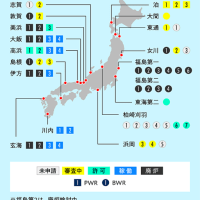Meltdown 101: Why is Fukushima crisis still out of control?
Workers at Japan's stricken Fukushima nuclear power plant are still days – if not weeks – away from bringing the crisis under control. The reason: nuclear fuel rods remain dangerously hot well after reactors are shut down, and all cooling systems at Fukushima have failed.
Washington
Emergency workers are still struggling to contain a crisis at a Japanese nuclear plant five days after an earthquake and tsunami pulverized Japan’s northeastern coast. Yet the reactors at the site shut down automatically when rocked by the quake March 11. Spent-fuel pools contain fuel rods removed from reactors months ago.
Tsunamis
Related stories
Spike in radiation forces Japan to suspend efforts to prevent nuclear meltdown
Radiation exposure: Why US is confident West Coast isn't in danger
Meltdown 101: What are spent-fuel pools and why are they a threat?
Meltdown 101: What is a nuclear reactor meltdown?
Topics
Science and Technology Energy Technology Nuclear Accidents and Disasters Industrial Accidents and Disasters Technology Nuclear Energy Accidents and Disasters
Why is it taking so long for all this fissile material at the Fukushima Daiichi complex to cool down?
The answer to that question is that, without artificial cooling, nuclear power-plant fuel remains “alive” enough to generate combustion-level amounts of heat and dangerous radioactivity for months on end. And at Fukushima, the earthquake and tsunami have knocked out these crucial artificial cooling systems.
RELATED: Japan's nuclear crisis:
Even if workers manage to restore core cooling systems to reactors and to get water levels back to normal in spent-fuel pools – a big “if” at this point – it will be some time before the situation is back under control, said David Lochbaum, director of the nuclear safety program at the Union of Concerned Scientists, in a conference call with reporters Tuesday.
“If they get those under control, they have about five days to a week before things get back to a stable level,” said Mr. Lochbaum.
The main problem: 'decay heat'
When reactors are shut down, the nuclear chain reaction which releases energy – and thus heat – from the uranium atoms of fuel shuts down as well. But the fuel continues to release smaller amounts of energy from the radioactive decay of fissile fragments.
This “decay heat” amounts to about 6 percent of the total heat generated by the reactor core when it is running, according to a fact sheet on nuclear energy physics from the World Nuclear Association, an industry trade group.
This decay heat falls off quite rapidly. After one hour, it will equal 1.5 percent of the previous core power, and so on. But the amount of energy generated by the core can be so enormous to begin with that even this residual heat can be dangerous. After one year offline, used fuel still emits about 10 kilowatts of decay heat energy per ton. After 10 years, it emits 1 kW of heat per ton.
“The decay heat produced is significant ... and systems must be provided to keep the reactor cool even after shutdown,” says a US Department of Energy handbook on nuclear physics.
Another problem: zirconium 'cladding'
It is not known how much nuclear material at the Fukushima plant is giving off decay heat, but those cooling systems have broken down in the wake of Japan’s natural disaster. Pumps have failed, exposing fuel rods in reactor cores to air for some period of time, causing damage yet unknown. Heat has caused water in spent-fuel pools to boil away, necessitating heroic attempts to try and spray or dump more water on the spent-fuel rods.
Adding to the problem, the zirconium alloy covering or "cladding" for the uranium pellets – which forms the fuel rods – oxidizes rapidly in the presence of air, heat, and steam, according to Arjun Makhijani, a nuclear expert and president of the Institute for Energy and Environmental Research.
This reaction itself releases large amounts of heat, adding to a situation where heat is already the primary enemy. The result of this oxidization can be a self-sustaining reaction, or zirconium cladding fire, that burns along the fuel rod, as a child’s sparkler burns up its length.
On Wednesday the International Atomic Energy Agency reported that Japanese authorities have “reported concerns” about the conditions of the spent-fuel pools at units 3 and 4 of the Fukushima Daiichi plant.CS Monitor 04/16/2011
炉心溶解101: 福島危機はなぜまだ制御しきれませんか?
日本の傷ついた福島原子力発電所の労働者は危機を規制するのからまだ何日(そうでなければ、何週間も)も後にいます。 理由: 原子炉が止められた後に、核燃料棒は危険に熱いままでよく残っています、そして、福島のすべてのクーリング・システムが失敗しました。
ワシントン
緊急作業員は、地震と津波が日本の北東の海岸を粉末にした5日後に、日本の原子力発電所に危機を含むようにまだ戦っています。 しかし、3月11日に揺れで強く揺すぶられると、サイトの原子炉は自動的に停止します。 使用済み核燃料プールは何カ月も前に原子炉から取り除かれた多量の燃科棒がそこにあります。
津波
関連話
核炉心溶解Radiation露出を防ぐための努力を続けてください。Meltdown101:米国が西海岸が安全であるという自信がある理由があるのですか。: 使用済み核燃料プールは何ですか、そして、それらはなぜ脅威ですか?
炉心溶解101: 原子炉炉心溶解は何ですか?
話題
福島第一の敷地のこのすべての核分裂性物質が治まるのに時間がかかりながら、科学、Technology Energy Technology Nuclear Accidents、Disasters Industrial Accidents、Disasters Technology Nuclear Energy Accidents、およびDisasters Whyはそれですか?
その質問の答えは、この福島第一原発の核燃料が冷房なしで何カ月も熱と危険な放射能の燃焼レベル量を続けて発生させることができるくらい「生きた」ままで残っているということです。 そして、福島では、地震と津波がこれらの重要な冷房システムを総てノックアウトしました。
関連する: 日本の核危機:
原子炉に炉心冷却系統を復旧し、労働者が何とか使用済み核燃料プール(ここの大きい“if")の標準に水位を取り戻しても、状況が再び制御されるまで、いくらかの時間がかかるでしょう、デヴィッドLochbaumは言いました、憂慮する科学者連盟の核安全計画のディレクター、火曜日のレポーターがいる電話会議で。
「それらについて抑えつけるなら、彼らには、いろいろなことが安定したレベルに戻る前に、約5日間から1週間があります。」と、Lochbaumさんは言いました。
主な障害: '崩壊熱'
原子炉が止められるとき、また、燃料のウラン原子からエネルギー(その結果、熱)を放出する核連鎖反応は、停止します。 しかし、燃料は、分裂性の断片の放射性崩壊から、よりわずかな量のエネルギーを放出し続けています。
この「崩壊熱」は原子炉が稼働しているとき炉心で発生する総熱量の約6パーセントに達します、World Nuclear Associationからの原子力物理学に関するデータ表によると、産業貿易使節団。
この崩壊熱は全く急速に落ちます。 1時間後に、それは前のコアパワーの1.5パーセントなどと等しいでしょう。 しかし、炉心で発生するエネルギー量が初めに非常に莫大である場合があるので、この残留熱さえ危険である場合があります。 1年後に、オフラインの、そして、中古の燃料は、まだ1トンあたりの約10キロワットの崩壊熱エネルギーを放っています。 10年後でも、それは、1トンあたりの1kWの熱を放ちます。これが使用済み核燃料の実態です。
「発生した崩壊熱は、最も重要です、そして、閉鎖の後にさえ原子炉を冷却状態に保つためにシステムを提供しなければなりません。」と、米国エネルギー省は言います。核物理学に関するハンドブック。
別の問題: ジルコニウム'被覆加工' 使用済み核燃料棒の懸念。
福島工場のどのくらいの核物質が崩壊熱を発しているかが知られていませんが、それらのクーリング・システムが日本の天災の後で故障しました。 いつかの期間にもかかわらず、損害を与えますが、未知のために炉心で燃科棒を露出して、ポンプは失敗しました。 使用済み核燃料プールの水は熱で沸騰して蒸発しました、使用済みの燃料棒の上の、より多くの水を注ぐかまたはどさっと落としてみることが必要としていました。
問題に加えて、InstituteのArjunマキジャニ、核専門家、および社長によると、ウランペレットのためのジルコニウム合金覆いか「被覆加工」が空気、熱、および蒸気があるときEnergyとEnvironmental Researchのために急速に酸化します。(ペレットは核燃科棒を形成しています)。
熱が既に第一の敵である状況に加えて、この反応自体は大量の熱をリリースします。 この酸化の結果は、燃科棒に沿って燃える自己持続型の反応、またはジルコニウム被覆炎であるかもしれません、小さな閃光が核燃料棒全体をを焼き尽くすとき。
水曜日に、国際原子力機関は、日本人の当局が福島第一工場の部隊unit3とunit4で使用済み核燃料プールの状態に関して「使用済み核燃料棒の懸念を報告した」と報告しました。CS Monitor 04/16/2011
Note: What is 101?
In help in a foreign search engine such as google, there are a lot of cases where Japanese is translated as it is, and the item of 101 now and then comes out.
Because Bing SEO measures etc. also have a lot of information from Japan in foreign countries, it is thought that foreign site might be referred to, and it thinks the content of how-to for the beginner when writing "SEO 101" and is almost correct.
They're 100th in the subject of the subject at the university in the United States,Because the number in 400th is attached, and the first 101st is specified for a beginner introductory subject most, generally 101 to show an introductory chapter.
I think almost the same nuance as "begginer" though it is thought that it never sees almost in Japan because this mode of expression is not general in countries other than the United States. As 4 202 is for the senior.
Note: 101 とは
google などの外国検索エンジンでのヘルプでは、そのまま日本語翻訳されているケースも多いようで、101 という項目がちょくちょく出てきます。
Bing SEO 対策なども、日本よりも海外の方に情報が多く存在しますので、海外サイトを参照することもあるかと思いますが、「SEO 101」と書いている場合、初心者向けのハウツー内容とみてほぼ間違いないです。
アメリカの大学では学科の科目に100番台~400番台の番号がついていたりして、一番最初の101番が初心者入門科目に指定されているため、一般的にも 101 というのは、入門編を表すことがならわしになっています。
この表現方法は、アメリカ以外の国では一般的ではないので、日本ではほとんど見ることがないかと思いますが、ほぼ「begginer」と同じニュアンスかと思います。ちなみ202は上級者向け。
Hazard: Danger. The old French . Original goes back to "Unhappy dice" . Arabia language al zahr (al definite article + zahr dice) in Spanish.
Hazard:危険。[古フランス語. もとはスペイン語で「不幸なサイコロ」. アラビア語al zahr (al定冠詞+zahrサイコロ)にさかのぼる]




















※コメント投稿者のブログIDはブログ作成者のみに通知されます